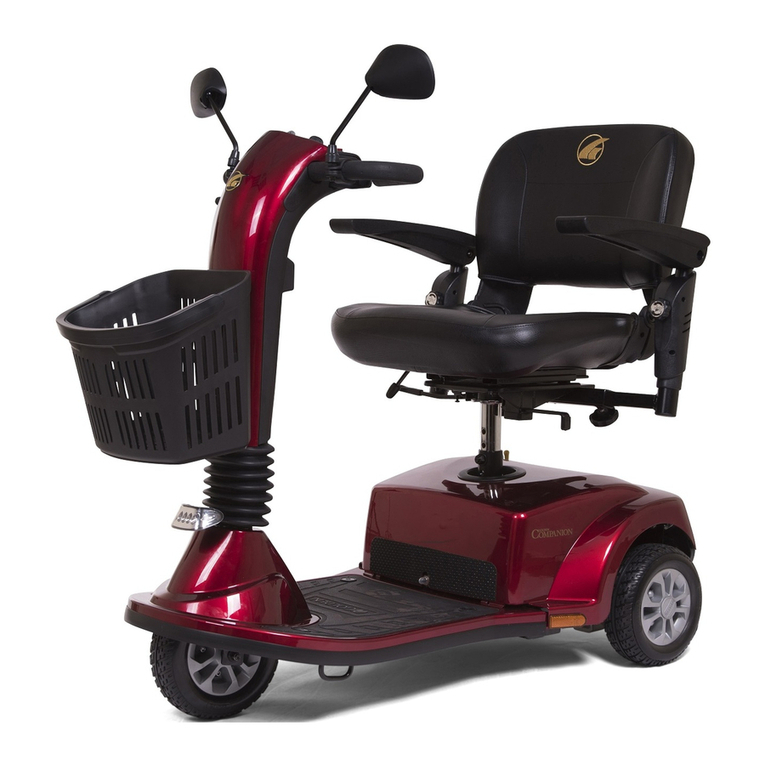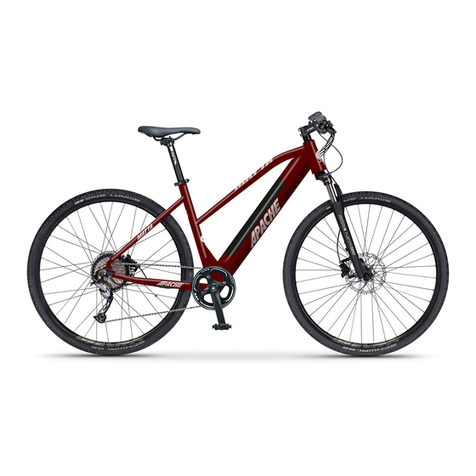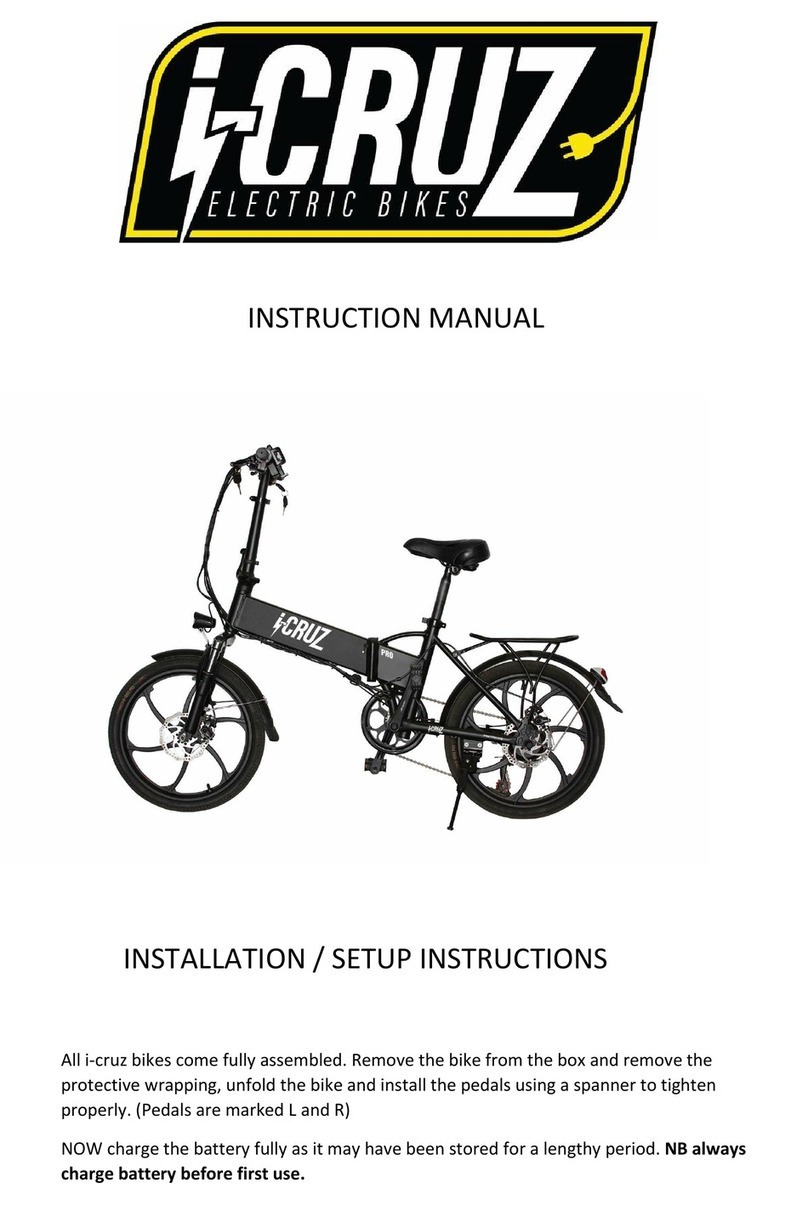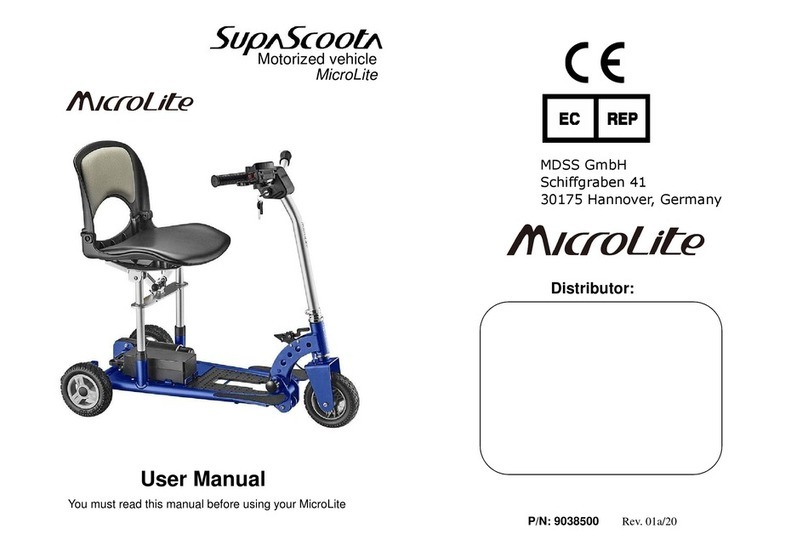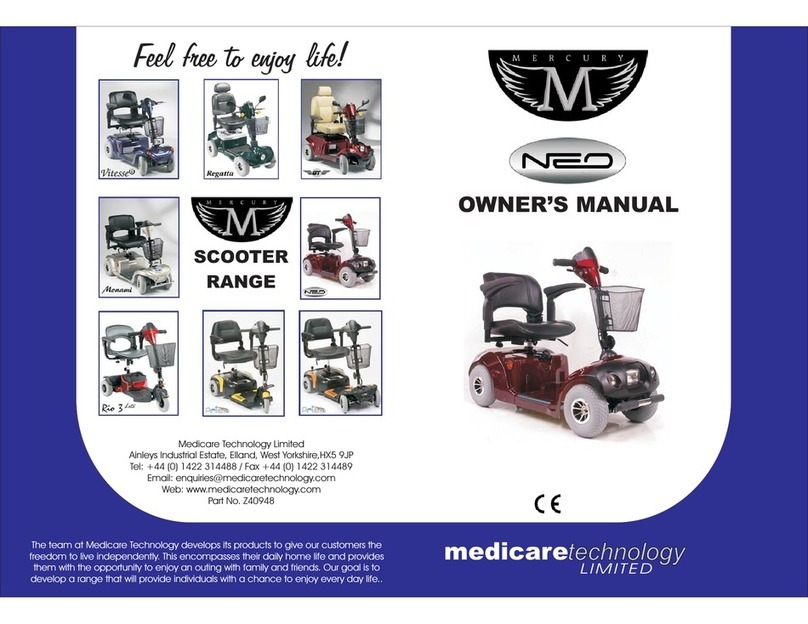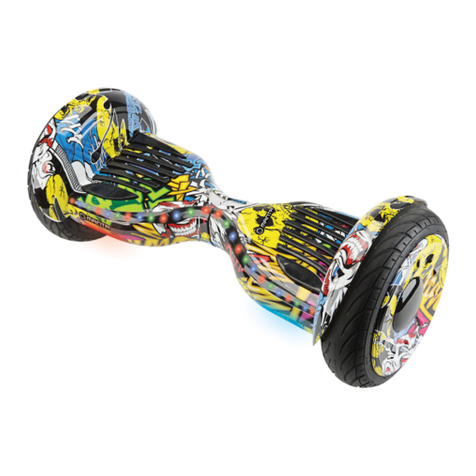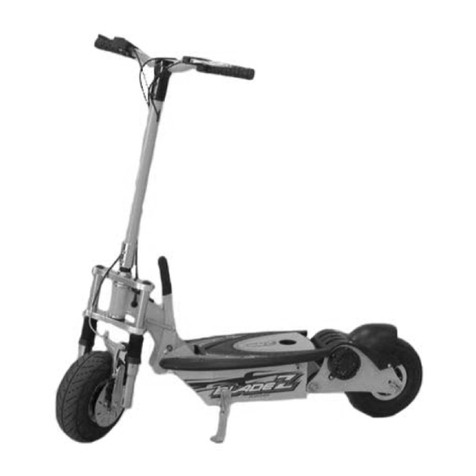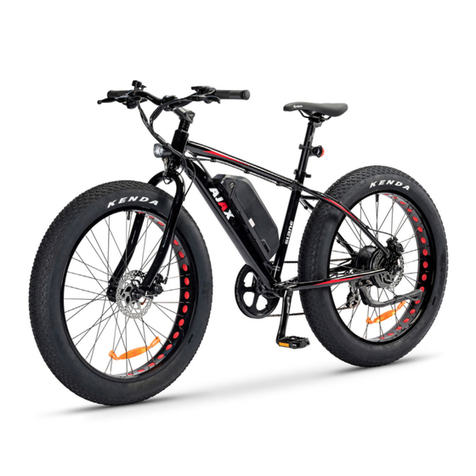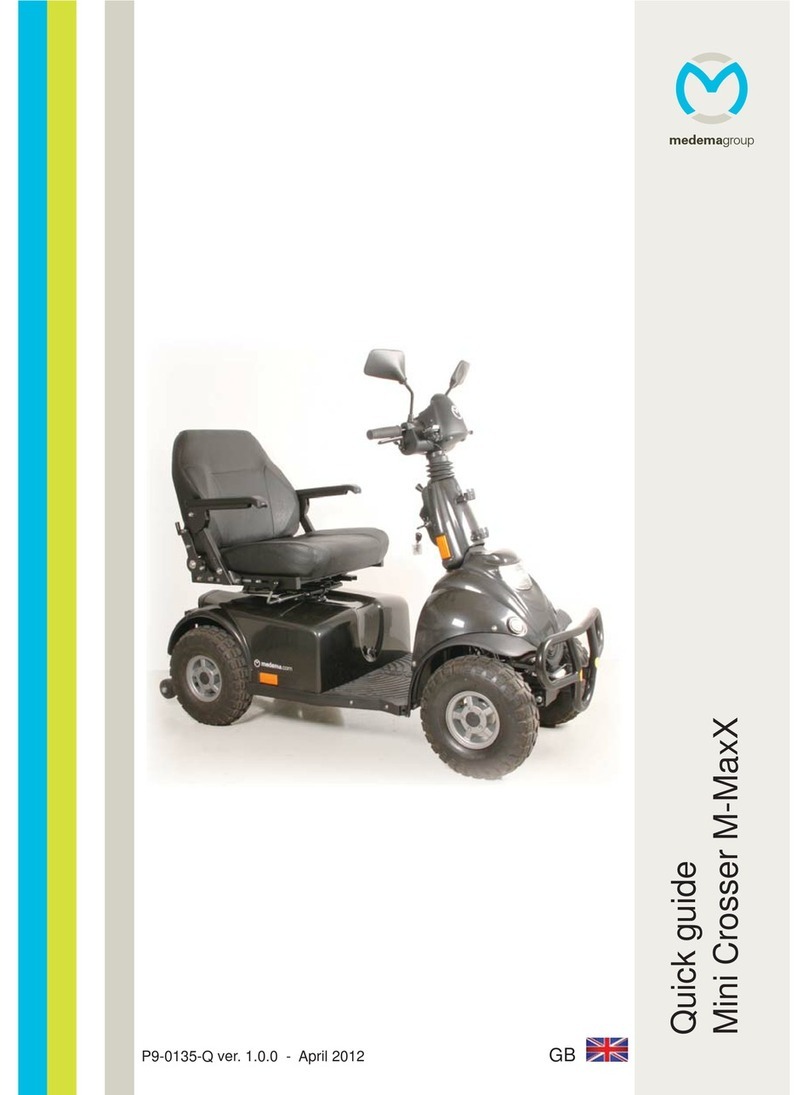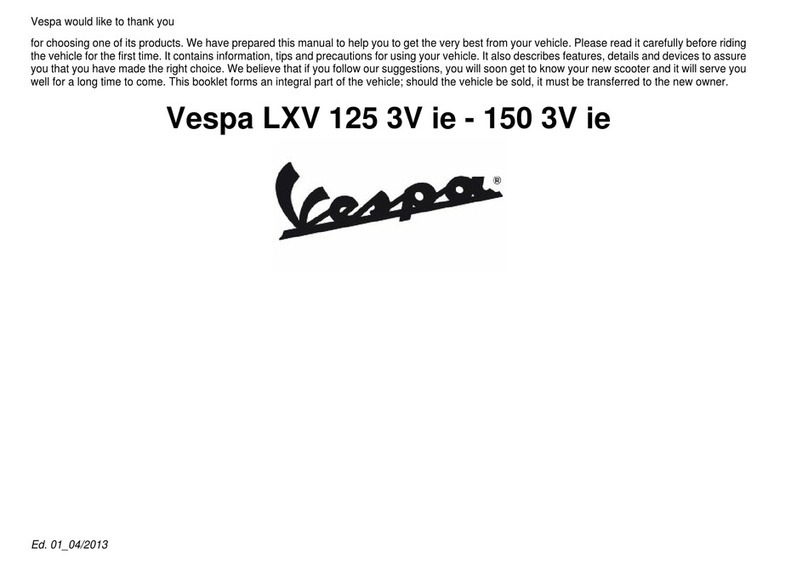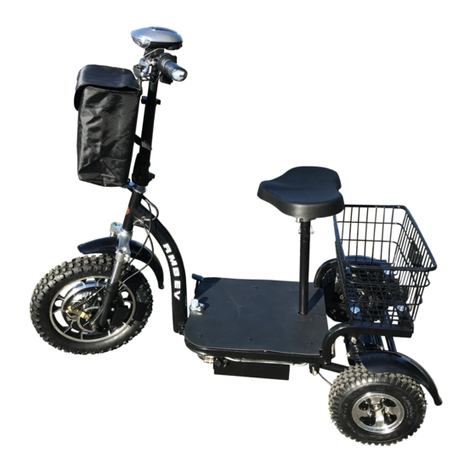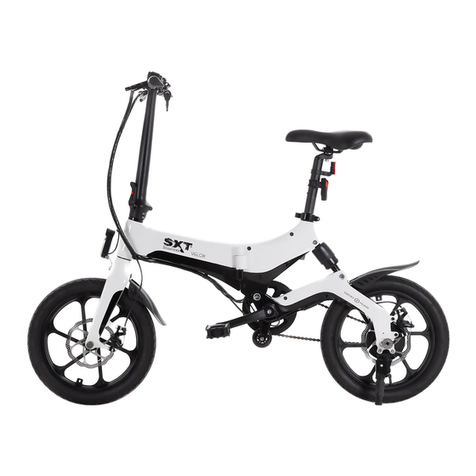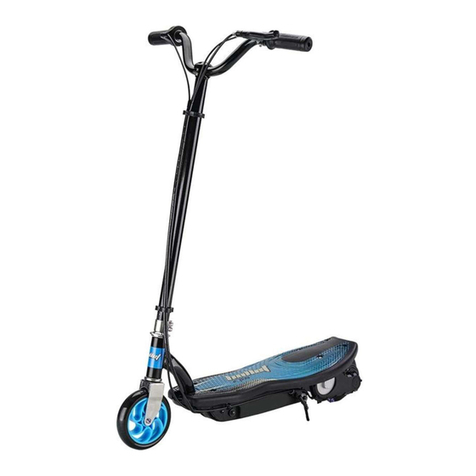Golden LiteRider GL140 User manual

LiteRider
Service Guide
This Service Guide contains:
Troubleshooting
Replacement Instructions
Illustrated Parts Breakdown
Model GL140
Model GL110

LiteRider_SG_REVA_040711
1

LiteRider_SG_REVA_040711
2
Table of Contents
Nomenclature and Contact Information.....................................................................................................................3
ABOUT THE LITERIDER SERVICE GUIDE......………………………………………………………………...4
LiteRider Components..................………………………………………………………………………………...4-8
Wiring Diagram..............……………………………………………………………………………………………9
SCENARIO 1: Turn the key to the on position and no power....................................……………………………..10
SCENARIO 2: Batteries will not charge..........................………………………………………………………….11
BEEP CODES......………………………………………………………………………………………………….12
BEEP CODE #1 – Batteries Low (Scooter may drive slowly).......………………………………………………..12
BEEP CODE #2 – Batteries Low (Scooter will not operate).......………………………………………………….12
BEEP CODE #3 - High Battery Voltage.....……………………………………………………………………….12
BEEP CODE #4 - Current Limit Timeout.........…………………………………………………………………...12
BEEP CODE #5 - Brake Fault.....…………………………………………………………………………….……13
BEEP CODE #6 - Paddle Fault (out of neutral)..... ………………………………………………………………..14
BEEP CODE #7 - Paddle Fault/Speed Control Fault (voltage error).....…………………………………………..15
BEEP CODE #8 - Motor Voltage Fault (Open/Shorted).....……………………………………………………….16
BEEP CODE #9 - Controller Fault.....……………………………………………………………………………..17
LITERIDER REPLACEMENT INSTRUCTIONS.....…………………………………………………………….18
Drive Wheel.....…………………………………………………………………………………………………….18
Drive Train....………………………………………………………………………………………………………18
Throttle Pot........…………………………………………………………………………………………………...18
Battery.........………………………………………………………………………………………………………..19
Circuit Breaker.....………………………………………………………………………………………………….20
Battery Harness Fuse....……………………………………………………………………………………………20
Controller........……………………………………………………………………………………………………..20
Main Harness.....……………………………………………………………………………………………………21
Control Panel.....……………………………………………………………………………………………………22
Brake....…………………………………………………………………………………………………………….22
APPENDIX A - HOW TO USE A VOLTMETER....……………………………………………………………..23
APPENDIX B - HOW TO USE AN OHM METER....……………………………………………………………24
APPENDIX C - WIRING DIAGRAMS....…………………………………………………………………….25-28
APPENDIX D - TROUBLESHOOTING FLOW CHARTS....………………………………………………..29-40
ILLUSTRATED PARTS BREAKDOWN
GL110..................................................................................................................................................................41-55
GL140..................................................................................................................................................................56-76

LiteRider_SG_REVA_040711
3
LITERIDER NOMENCLATURE
1 - Seat Assembly with arms
2 - Control Panel
3 - Off-Board Battery Charger
4 - Battery Pack
5 – Rear Frame
6 - Motor/Brake Assembly
7 - Drive Wheel
8 - Front Frame
9 - Controller
10 - Floor Basket
11 - Tiller
12 - Rear Plastic Floor Mat
13 - Front Wheel
14 - Front Basket
15 - Front Plastic Floor Mat
Figure 1. LiteRider 4-wheel (shown above)
Contact Information
Golden Technologies
401 Bridge Street
Old Forge, PA 18518
Toll-free: 800-624-6374
Fax: 800-628-5165
Lift Chair/Bed Tech: x645
Mobility Tech: x648
VA Tech: x647
5
6
7
8
9
3
4
2
1
10
11 12
13
14
15

LiteRider_SG_REVA_040711
4
ABOUT THE LITERIDER™ SERVICE GUIDE
This service guide provides you with the information necessary to troubleshoot the Golden Technologies LiteRider
GL110/GL140. The troubleshooting scenarios in this manual consist of procedures that enable you to systematically trace
and correct faults in the system. Appendices A and B include instructions on how to measure voltage and continuity with
a multimeter. Appendix C includes a copy of figure 8 that may be printed separately. Appendix D contains flow charts of
the more complex troubleshooting procedures.
Before troubleshooting, check the following:
• Make sure that the circuit breaker is reset.
• Visually check terminals for corrosion. Check wires for missing insulation.
• Make sure that the batteries are fully charged and are in good working order. When possible, keep sets of
known good batteries of various ratings in your shop at all times. The LiteRider uses two (2) 18AH
batteries. Problems that surface during troubleshooting are often due to the fact that the batteries are not
fully charged or can not hold their charge.
• Make sure that the electrical connections are secure. Unplug the connectors and make sure all of the pins
are seated properly. Push the pins back into the connector housing if necessary. Make sure that the battery
terminals are tight.
NOTE: If you get to a point during troubleshooting where you cannot continue, call tech support at 800-624-6374.
LITERIDER COMPONENTS
The LiteRider is a battery-operated scooter with a controller that monitors the system and beeps when it detects a fault in
the system. The LiteRider was designed to operate within a range of between 18 – 24 volts (V) of direct current (DC).
The LiteRider control system is made up of the following components:
NOTE: The number after the component refers to the components position on figure 8 on page 9.
• Circuit Breaker (1)
• 12V Batteries (2 and 3)
• Battery Harness (4)
• Power Harness (5)
• Dynamics R-Series Controller (6)
• Main Harness (7)
• Front Intermediate Motor Harness (8)
• Rear Intermediate Motor Harness (9)
• Motor/Brake Assembly (10)
• Brake (11)
• Control Panel (12) includes Key Switch and Speed Control
• Throttle Pot (13)
• Charger Harness (14)
• Off-Board Battery Charger – (not shown in illustration)
NOTE: Parts and service must be authorized by the Golden Technologies Service Department. Unauthorized
parts or service may void the warranty. For more information, contact the Golden Technologies Service

LiteRider_SG_REVA_040711
5
NOTE: The number after each component refers to the components position in figure 8 on page 9.
Component: Circuit Breaker (1)
Location: Mounted on the Battery Pack. See #1 on figure 2.
Function: Protects battery circuit from current overload. When the current draw exceeds the breaker rating, the circuit
breaker will open.
Connections: The circuit breaker is connected to the positive (+) terminal on one battery and the negative (-) terminal on
the other.
Failure Signs: Opens repeatedly. May indicate failed circuit breaker or short in the wiring. May also open if the motors
are overloaded (from excessive weight, excessive uphill driving, etc).
Test: Measure the resistance across the circuit breaker and the wires that connect the circuit breaker to the batteries.
Expected reading: Less than 10 ohms.
Serviceable: Circuit breaker must be replaced with exact current rating.
2
4
5
6
3
1
Figure 2. Inside Battery Pack
Component: 12VDC Batteries (2 and 3)
Location: Inside the battery pack. See #2 and #3 on figure 2.
Function: Supply 24VDC to the motor and/or accessories (12VDC x 2).
Connections: Connected in series. The positive (+) terminal of one battery is connected to the negative (-) of the
other at the circuit breaker (1) and at the battery harness (4c and 4d). Refer to figure 8 on page 9.
Failure Signs: Batteries drain quickly. Scooter runs slowly or not at all. Batteries will not charge, but charger is
working properly. Beep Code #1 or #2.
Tests: Fully charge the batteries first and load test. Make sure charging system is working. See Battery Charging
Test. Make sure the contacts are not corroded. See figure 16 on page 13 for quarter test.
Expected Readings: 12 - 14VDC each when fully charged.
Serviceable: Replace batteries as necessary.
Component: Battery Harness (4)
Location: Inside the battery pack. See #4 on figure 2.
Function: Connects the batteries to the Power Harnesses (5). Provides over current protection from the battery
charger through a 3-amp inline fuse.
Connections: Connected to the power harness through 4a. Connected to the charger harness through 4b.
Connected to the batteries through 4c (+) and 4d (-). Refer to figure 8 on page 9.
Failure Signs: Corroded wires may cause the batteries not to work properly. Make sure connector pins are seated
properly. Batteries will not charge if the inline fuse is blown.
Tests: Test the harness for continuity. Test the fuse for continuity.
Expected Readings: Less than 10 ohms.
Serviceable: Replace the harness as necessary. Replace inline fuse with exact type and rating. See #5 on figure 2.

LiteRider_SG_REVA_040711
6
1
2
3
Figure 3. Controller
Component: Power Harness (5)
Location: Mounted to the front frame - under the battery pack. See #1 on figure 3.
Function: Connects the battery pack to the controller.
Connections: Connects to the battery pack (4a). Connects to the controller 5b (inhibit), 5c (Bat -), and 5d (Bat +).
Refer to figure 8 on page 9.
Failure Signs: Charger is on and connected to the battery pack and the scooter runs (inhibit). No power to the controller.
Tests: Test harnesses for continuity. Check connectors. Make sure the contacts are not corroded and are seated properly.
Expected Readings: Continuity (less than 10 ohms).
Serviceable: Replace as necessary.
Component: Controller (6)
Location: Under the rear floor mat. See #2 on figure 3.
Function: Controls and monitors the system. Uses a series of beeps when something in the system is out of range.
Connections: Connected to the main harness (7a), the charger inhibit (5b), the motor brake (8b), the front
intermediate motor harness negative (8c), the front intermediate motor harness positive (8d), the power harness
negative (5c) and the power harness positive (5d). Refer to figure 8 on page 9.
Failure Signs: Beep Code #9. No power to the control panel or the motor.
Tests: Test for voltage coming into and out of the controller.
Expected readings: Battery voltage.
Serviceable: Replace as necessary.
Component: Main Harness (7)
Location: Inside the tiller and under the frame. See #3 on figure 3.
Function: Provides connectivity for the tiller components and the controller.
Connections: Connected to the controller (6) and the control panel (12b). Refer to figure 8 on page 9.
Failure Signs: Scooter will not run.
Tests: Test for voltage and continuity. Check connectors. Make sure the pins are not corroded and are seated properly.
Expected readings: Battery voltage. Continuity (less than 10 ohms).
Serviceable: Replace as necessary.

LiteRider_SG_REVA_040711
7
Component: Front Intermediate Motor Harness (8)
Location: Mounted on the front frame. See #1 on figure 4.
Function: Provides connectivity for rear intermediate motor 2
harness and the controller.
Connections: Connected to the rear intermediate harness (9a)
and the controller (6). Refer to figure 8 on page 9.
Failure Signs: Scooter will run slowly or not at all. 1
Tests: Test for voltage and continuity. Check connectors.
Make sure the pins are not corroded and are seated properly.
Expected readings: Continuity (less than 10 ohms).
Serviceable: Replace as necessary.
Component: Rear Intermediate Motor Harness (9)
Location: Mounted on the rear frame. See #2 on figure 4. Figure 4. Intermediate Motor Harnesses
Function: Provides connectivity for front intermediate
motor harness and the motor/brake assembly.
Connections: Connected to the front intermediate motor
harness (8a) and the motor/brake assembly (10a).
Refer to figure 8 on page 9.
Failure Signs: Scooter will run slowly or not at all.
Tests: Test for voltage and continuity. Check connectors.
Make sure the contacts are not corroded. (See figure 16
on page 13 for quarter test).
Expected readings: Continuity (less than 10 ohms).
Serviceable: Replace as necessary.
2
Component: Motor/Brake Assembly (10) 1
Location: Mounted on the transaxle. See #1 on figure 5.
Function: Drives the scooter.
Connections: Connected to the rear intermediate motor
harness (9b) and the brake (11a). Refer to figure 8 on page 9. Figure 5. Motor/Brake Assembly
Failure Signs: Scooter runs slowly or not at all.
Tests: Test for internal resistance in motor. Test motor
wires for continuity. See Beep Codes #5 and #8.
Expected readings: Internal motor resistance is less than 50 ohms but not shorted.
Brake resistance is less than 80 ohms but not shorted.
Serviceable: Replace the rear frame assembly.
Component: Brake (11)
Location: Mounted on the end of the motor. See #2 on figure 5.
Function: Keeps the motor from moving when the power is off.
Connections: Connected to the motor harness (10b). Refer to figure 8 on page 9.
Failure Signs: Scooter runs slowly or not at all.
Tests: Test for internal resistance. See Beep Code #5 on page 13 and Beep Code #8 on page 16.
Expected readings: Brake resistance is less than 80 ohms but not shorted.
Serviceable: Replace the park brake.
Component: Speed Pot
Location: Mounted on the control panel (12). See #1 on figure 6 on page 8.
Function: The speed potentiometer (pot) uses variable resistance to control the speed of the scooter.
Connections: Connected to the main harness through the control panel harness.

LiteRider_SG_REVA_040711
8
Failure Signs: Beep Code #7
Tests: Call Tech Support
Expected readings: Depends on speed pot position.
Serviceable: No. Replace the control panel.
Component: Key Switch
Location: Mounted on the control panel (12). See #2 on figure 6.
Function: Completes the circuit to provide power to the motor.
Connections: Connected to the main harness through the
control panel harness.
Failure Signs: No power when the key is in the ON position.
Tests: Continuity when the key is in the “ON” position. Make
sure the connector pins are seated properly.
Expected readings: Less than 10 ohms.
Serviceable: No. Replace the control panel.
Component: Throttle Pot (13) 1
Location: Under the control panel. See #1 on figure 7.
Function: The throttle pot (potentiometer) uses variable
resistance to control speed and direction of travel by varying voltage.
Connections: Connected to the control panel harness (12a). 2
Refer to figure 8 on page 9.
Failure Signs: Beep Codes #6 and #7.
Tests: Test resistance across the pins 1, 2, and 3 and on 13a.
Expected readings: Depends on direction of deflection.
Serviceable: Replace as necessary.
Component: Charger Harness (14) Figure 6. Control Panel (Back)
Location: Inside the battery pack. See #6 on figure 2 on page 5.
Function: Connects charger to battery harness.
Connections: Connected to the battery harness (4a) and the
charger, which is not shown. Refer to figure 8 on page 9. 1
Failure Signs: Batteries will not charge.
Tests: Test for voltage and continuity. Check connectors.
Make sure the pins are not corroded and are seated properly.
Expected readings: Continuity (less than 10 ohms).
Serviceable: Replace the harness as necessary.
Component: Off-Board Battery Charger
Location: Stored inside a pouch on the seatback.
Function: Recharges batteries.
Connections: Connects to the charger port on the battery pack (14b).
Refer to figure 8 on page 9. Charger harness is located inside the battery Figure 7. Throttle Pot
pack. Connects the charger to the main harness.
Failure Signs: Charger power LED does not go on. Batteries will not charge.
Tests: Charger tests vary. Some chargers may be tested by measuring positive
and negative leads on the charger connector. Other chargers need to see
battery voltage before charging.
Expected reading: Varies with charger.
See charger test on page 11.
Test charger harness and fuse for continuity.
Serviceable: Replace if necessary.
NOTE: Some Off-Board Battery Chargers may have a switch
that enables them to be used with either 110 VAC or 230 VAC.
This switch is typically located on the end of the charger. Some
may also have a removable glass fuse.
*Fuses must be replaced with exact type and rating.*

LiteRider_SG_REVA_040711
9
DYNAMIC R-SERIES
CONTROLLER
1
5
4
8
7
14
1
8
13a FRONT
THROTTLE
POT (13)
SPEED POT
KEY
SWITCH CONTROL
PANEL (12)
BATTERY
(2)
BATTERY
(3)
CHARGER
HARNESS (14)
BATTERY
HARNESS (4)
INSIDE BATTERY PACK
CIRCUIT BREAKER (1)
POWER
HARNESS
(5)
FRONT
INTERMEDIATE
HARNESS (8)
REAR
INTERMEDIATE
HARNESS (9)
10a FRONT
RED BLACK
BLUEORANGE
BLUE
ORANGE
RED
ORANGE
ORANGE
BLUE
YELLOW
PURPLE
BLACK
WHITE
WHITE
RED
PURPLE
ORANGE
YELLOW
GREEN
BLACK
BLUE
BLUE
ORANGE
YELLOW
RED
BLACK
BLUE
ORANGE
GREEN
BLACK
RED
GREEN
BLACK
RED
RED
FUSE
MAIN
HARNESS (7)
MOTOR/BRAKE ASSEMBLY
(
10
)
BRAKE
(11)
12a
13a 7b
12b
4c
4d
4b 14a 14b
4a
5a
7a
5b
8b
8c
8d
5c
5d
8a
9a
9b10a
10b
11a
7a FRONT7b FRONT
Figure 8. LiteRider Wiring Diagram

LiteRider_SG_REVA_040711
10
SCENARIO 1: TURN THE KEY TO THE ON POSITION AND NO POWER
Put the key into the key switch and turn to the on position. There is no power to the control panel. The horn does
not work and the battery condition meter does not work. Battery voltage travels from the batteries, through the
controller and the key switch. The test below will verify that there is battery voltage at the batteries, the controller,
the main harness, and the key switch. Refer to Appendix D on pages 29-39 for troubleshooting flow charts.
NOTE: Make sure that the batteries are fully-charged and connected properly. Refer to the battery connection diagram
inside the battery pack. If the batteries are not fully charged and connected properly, then voltage measurements may
produce faulty readings. Measure voltage across pin 1 and pin 3 on the battery pack to get total battery voltage
(approximately 24VDC). Refer to figure 8 on page 9. If the batteries will not charge, go to “Scenario 2: Batteries will not
charge.”
Check Battery Voltage at Battery Pack.
1) Remove the battery pack.
2) Measure voltage across terminals 1 and 3 on connector
4a. See figure 9.
• 24VDC (or battery voltage?) - Go to the next step.
• More than 16VDC? - Try to recharge the batteries.
Load test and replace if necessary.
• 0VDC? - Check main circuit breaker (1) and battery
harnesses for continuity (4a terminals 1 to 4c and 4a
terminals 3 to 4d).
Check Voltage at Power Harness.
3) Remove the floor basket.
4) Remove the two screws that fasten the rear floor mat to
the front frame.
5) Disconnect the power harnesses (5c and 5d) from the
controller.
6) Reinstall the battery pack.
7) Measure voltage across 5c and 5d. See figure 10.
• 24VDC (or battery voltage?) - Go to the next step.
• 0VDC? - Check power harness for continuity.
Replace as necessary.
Check Voltage Out of Controller.
8) Reconnect the power harness to the controller.
9) Insert the multimeter probes into the terminal with the red
wire (pin 7) and the terminal with the black wire (pin 13)
on the back of the main harness connector 7a. See
figure 11.
• 24VDC (or battery voltage?) - Go to the next step.
• 0VDC? - Replace the controller.
Check Voltage at Main Harness.
10) Open the control panel.
11) Disconnect the main harness (7b) from the control panel
harness.
12) Measure voltage across pin 3 (black wire) and pin 8 (red
wire) on connector 7b. See figure 12.
• 24VDC (or battery voltage?) - Replace the control
panel.
• 0VDC? - Replace the main harness.
Figure 9. Connector 4a
Figure 10. Connectors 5c and 5d
Figure 11. Back of Connector 7a
Figure 12. Connector 7b
RED +
BLACK -RED +
RED +
BLACK -
BLACK -
GREEN
GREEN
RED +
BLACK -BLACK -
RED +
POWER
HARNESS (5)
BACK
VIEW

LiteRider_SG_REVA_040711
11
SCENARIO 2: BATTERIES WILL NOT CHARGE
Most battery chargers need to “see” at least 16VDC at the charger port. Otherwise, they may not send a charging
current to the batteries. This test will ensure that the battery voltage is making it to the charger port. You will need
to check battery voltage and wiring harness continuity inside the battery pack.
Check Battery Charger Voltage.
1) Remove the battery pack.
2) Plug the charger into the charger port and then into a wall outlet.
3) Measure voltage across terminal 1 and terminal 3 on 4a. See figure 13. Does the voltage increase?
• Yes? - Load test the batteries and replace as necessary.
• No? - But there is voltage. If the voltage is lower than 16VDC, then replace the batteries. If the voltage
is 16VDC or greater, then go to the next step.
• No? - And there is no voltage. Open the battery pack and check the circuit breaker and the battery
harnesses for continuity. Replace the individual components as necessary.
Figure 13. Connector 4a
4) Open the battery pack.
5) Check the battery harness fuse for continuity.
• Less than 10 ohms? – Replace the charger harness.
• Open? – Replace the fuse. See #1 on figure 14.
1
Figure 14. Battery Harness Fuse
RED +
BLACK -

LiteRider_SG_REVA_040711
12
BEEP CODES
The controller uses audible beeps to indicate the status of the system. When the controller notices that there is
a malfunction in the system, it will beep a code when the power is on. For example, when it beeps five times and
stops that indicates beep code #5 – Brake Fault.
The following beep codes are used to help diagnose system errors:
Beep Code #1 – Batteries Low (Scooter will operate)
Beep Code #2 – Batteries Very Low (Scooter will not operate)
Beep Code #3 – High Battery Voltage
Beep Code #4 – Current limit timeout
Beep Code #5 – Brake Fault
Beep Code #6 – Paddle Fault (out of neutral)
Beep Code #7 – Paddle Pot/Speed Pot Fault
Beep Code #8 – Motor Voltage Fault (Open/Shorted)
Beep Code #9 – Controller Fault
BEEP CODE #1 – BATTERIES LOW (SCOOTER MAY DRIVE SLOWLY)
This Beep Code occurs when the battery voltage drops below a certain level. Recharge the batteries immediately.
If the batteries will not recharge, then load test them or refer to “Scenario 2: Batteries will not Charge”, on page 11.
BEEP CODE #2 – BATTERIES LOW (SCOOTER WILL NOT OPERATE)
This Beep Code occurs when the battery voltage drops lower than Beep Code #1. Recharge the batteries immediately.
If the batteries will not recharge, load test them or refer to “Scenario 2: Batteries will not Charge”, on page 11.
BEEP CODE #3 - HIGH BATTERY VOLTAGE
This Beep Code occurs when the battery voltage climbs above 26VDC.
1) Insert the key into the key switch and turn it to the on position. Allow the battery level to drop. Do not
allow the battery voltage to fall into the red area on the battery meter.
2) Check the battery charger. Make sure it is an approved charger.
BEEP CODE #4 - CURRENT LIMIT TIMEOUT
This Beep Code occurs when the motor has been exceeding its maximum current rating for too long. This may be
due to a faulty motor, poor battery condition, excessive uphill driving, or excessive weight. First turn off the scooter
and allow it to cool for ten minutes. If this does not work, use the following procedure.
Inspect Motor/Brake and Rear Intermediate Motor Harness Connectors.
1) Remove the seat.
2) Remove the battery pack.
3) Inspect the connection between the motor/brake assembly (10a) and the rear intermediate motor harness
(9b). Are either connectors discolored or melted? Refer to figure 8 on page 9.
• Yes? - Replace the drivetrain assembly or rear intermediate motor harness as necessary.
• No? - Go to the next step.
Check Motor Resistance at Motor.
4) Disconnect the motor (10a) from the rear intermediate
motor harness (9b).
5) Measure resistance across the two pins on connector 10a
that have the thick black wire and the thick red wire
(Internal resistance of the motor). See figure 15.
• 50 ohms or less but not shorted? (NOTE: Can be as Figure 15. Connector 10a
low as 0.2 ohms). – Go to the next step.
• Out of that range? – Replace the drivetrain assembly.
BLACKRED

LiteRider_SG_REVA_040711
13
Check for Continuity between Front and Rear Intermediate Motor Harnesses.
7) Remove the seat.
8) Remove the floor basket.
9) Remove the two screws that fasten the rear floor mat to the front frame.
10) Disconnect the front intermediate motor harness (8c and 8d) from the controller. Refer to figure 8 on page 9.
11) Make sure that the pins are seated properly on 9b. Check the continuity between 8c/8d and 9b.
• 10 ohms or less? – Replace the controller.
• Open? – Go the next step.
12) Separate the drivetrain from the front frame.
13) Inspect the front and rear intermediate motor harness connectors. Are they discolored or corroded?
• Yes? - Replace as necessary.
• No? - Go to the next step.
14) Take a quarter and slide into the contacts 1
marked “+” and “-” on the front intermediate
motor harness connector. (See #1 in figure 16).
Does each contact hold the quarter firmly
in place?
• No? - Replace the front intermediate motor harness.
• Yes? - Go to the next step.
15) Check the front intermediate motor harness
and the rear intermediate motor harness for
continuity.
• 10 ohms or less? – Replace the controller. Figure 16. Quarter Test
• Open? – Replace as necessary.
BEEP CODE #5 - BRAKE FAULT
This Beep Code occurs because the park brake release switch is active or the park brake may be faulty.
Check the Park Brake Position.
1) Turn the key to the off position.
2) Disengage and then re-engage the park brake.
3) Turn the key to the on position. Did the beep code clear?
• Yes? - OK.
• No? - Go to the next step.
Check Park Brake Resistance at the Controller.
4) Remove the seat.
5) Remove the battery pack.
6) Remove the floor basket.
7) Remove the rear floor mat.
8) Disconnect the front intermediate motor harness
(8b) from the controller. Refer to figure 8 on page 9.
9) Make sure that the pins on 8b are seated
properly. Measure resistance across pin 1
and pin 2 on the front intermediate motor
harness (8b) with park brake engaged.
See figure 17.
• 80 ohms or less but not shorted? –
Replace the controller. Figure 17. Connector 8b
• Shorted or open? – Go to the next step.
BLUEORANGE

LiteRider_SG_REVA_040711
14
Check the Continuity Between the Front and Rear Intermediate Motor Harnesses.
10) Unplug the motor harness (10a) from the rear intermediate motor harness (9b). Refer to figure 8 on page 9.
11) Make sure that the pins are seated properly on 10a. Check the continuity between 9b and 8b.
• 10 ohms or less? – Go to step 15.
• Open? – Go the next step.
12) Separate the drivetrain from the front frame.
13) Inspect the connection between the front intermediate motor harness (8a) and the rear intermediate motor
harness (9a). Refer to figure 8 on page 9. Make sure the contacts are not corroded. Take a quarter and slide
into the contacts on 8a not marked “+” and “-” on the connector. (Similar to #1 in figure 16 on page 13).
Does each contact hold the quarter firmly in place?
• No? - Replace the front intermediate motor harness.
• Yes? - Go to the next step.
14) Check the front intermediate motor harness and the rear intermediate motor harness for continuity.
• 10 ohms or less? – Go to the next step.
• Open? – Replace as necessary.
Check Resistance at Park Brake.
15) Unplug the park brake (11a) from the motor
harness (10b). Refer to figure 8 on page 9.
Check the pins on the park brake connector (11a).
Make sure they are seated properly.
16) Measure resistance across pin 1 and pin 2
on the park brake (11a) with park brake
engaged. See figure 18.
• 80 ohms or less but not shorted? – Replace
the drivetrain assembly. Figure 18. Connector 11a
• Shorted or open? – Replace the park brake.
BEEP CODE #6 - PADDLE FAULT (OUT OF NEUTRAL)
This Beep Code means that the throttle control lever was not in the neutral position when the key is turned to the
on position.
1) Turn the key to the off position.
2) Make sure that the paddle pot is not obstructed and it can return to the neutral (center) position.
3) Move the throttle pot forward and then reverse. Make sure that it is not obstructed. Does it spring back
to the neutral position?
• Yes? – Go to the next step.
• No? – Check for obstructions. Adjust if necessary. Replace if the adjustment does not work or if
there are no obstructions.
4) Turn the key to the on position. Does the code return?
• No? – OK
• Yes? – Go to Beep CODE #7 to test the paddle pot.
BLACKBLACK

LiteRider_SG_REVA_040711
15
BEEP CODE #7 - PADDLE POT/SPEED CONTROL FAULT
This Beep Code occurs because there is a fault with the throttle pot,
speed pot, or the associated wiring.
Check Throttle Pot Resistance at Controller.
1) Remove the seat.
2) Remove the floor basket.
3) Remove the two screws that fasten the rear floor
mat to the front frame.
4) Turn the speed pot to full rabbit.
5) Set your multimeter to measure resistance.
6) Disconnect the main harness (7a) from the
controller. Refer to figure 8 on page 9. Figure 19. Connector 7a
7) Insert multimeter probes into the main harness
connector 7a at pin 8 and pin 2 (blue wire and
orange wire). See figure 19.
• 2.5k ohm ±10%? - go to the next step.
• Outside that range? - Go to step 9.
8) Insert the multimeter probes into the main
harness connector 7a at pin 1 and pin 8
(blue wire and yellow wire). See figure 20.
Note the resistance reading. Insert the
multimeter probe into the main harness
connector at pin 1 and pin 2 (yellow wire and
orange wire). See figure 21. Note the resistance reading. Figure 20. Connector 7a
• Are both readings within 500 ohms of each
other? - Replace the controller.
• Are either readings outside that range? - Go
to the next step.
Check Throttle Pot Resistance at Throttle Pot.
9) Open the control panel.
10) Disconnect the control panel harness (12a) from
the throttle pot (13a). Refer to figure 8 on page 9.
11) Insert multimeter probes into the throttle pot
connector (13a) at the blue wire and the orange Figure 21. Connector 7a
wire (outside two pins). See figure 22.
• 2.5k ohm ±10%? - go to the next step.
• Outside that range? - Replace the throttle
pot.
Figure 22. Connector 13a
ORANGE
BLUEBLUE
BLUE
ORANGE
ORANGE
YELLOW
YELLOW
YELLOW
7a FRONT
7a FRONT
7a FRONT

LiteRider_SG_REVA_040711
16
12) Insert the multimeter probes into the throttle
pot connector (13a) at the orange wire and the
yellow wire. See figure 23. Note the resistance
reading. Insert the multimeter probes into the
throttle pot connector (13a) at the yellow wire
and the blue wire. See figure 24. Note the
resistance reading.
• Are both readings within 500 ohms of each
other? - Go to the next step.
• Are either readings outside that range? – Figure 23. Connector 13a
Replace the throttle pot.
13) Check the orange, blue, and yellow wires on
the main harness for continuity.
• 10 ohms or less on each one? - Replace the
control panel.
• Open on any wire? - Replace the main
harness.
BEEP CODE #8 - MOTOR VOLTAGE FAULT (OPEN)
This Beep Code occurs when there is an internal
problem with the motor or its wiring.
Check Motor Resistance at Controller. Figure 24. Connector 13a
1) Remove the seat.
2) Remove the floor basket.
3) Remove the two screws that fasten the rear
floor mat to the front frame.
4) Disconnect the front intermediate motor
harnesses (8c and 8d) from the controller.
Refer to figure 8 on page 9.
5) Measure resistance across the front intermediate
motor harness 8c and 8d. See figure 25.
• 50 ohms but not shorted? (NOTE: Can
be as low as 0.2 ohms). – replace the controller.
• Out of that range? – Go to the next step.
Check Continuity Between Front and Rear Intermediate
Motor Harnesses.
6) Unplug the motor/brake assembly (10a) from
the rear intermediate motor harness (9b). Figure 25. Connectors 8c and 8d
Refer to figure 8 on page 9.
7) Make sure that the pins are seated properly on
9b. Check the continuity between 8c/8d and 9b.
• 10 ohms or less? – Go to step 13.
• Open? – Go the next step.
8) Remove the battery pack.
9) Separate the drivetrain from the front frame.
10) Inspect the front and rear intermediate motor harness connectors. Are they discolored or corroded?
• Yes? - Replace as necessary.
• No? - Go to the next step.
ORANGE
ORANGE
BLUE
BLUE
YELLOW
YELLOW
ORANGE
BLUE
BLAC
K
RED
FRONT INTERMEDIATE
MOTOR HARNESS (8)

LiteRider_SG_REVA_040711
17
11) Take a quarter and slide into the contacts
marked “+” and “-” on the front intermediate
motor harness connector. (See #1 in figure 16
on page 13). Does each contact hold the quarter
firmly in place?
• No? - Replace the front intermediate
motor harness.
• Yes? - Go to the next step. Figure 26. Connector 10a
12) Check the front intermediate motor harness
and the rear intermediate motor harness for continuity.
• 10 ohms or less? – Go to the next step.
• Open? – Replace as necessary.
Check Motor Resistance at Motor.
13) Make sure that the pins are seated properly on 10a. Disconnect 10a from 9b if necessary.
Refer to figure 8 on page 9.
14) Measure resistance across pin 1 (thick red wire) and pin 2 (thick black wire) on 10a. See figure 26.
• 50 ohms or less but not shorted?
(NOTE: Can be as low as 0.2 ohms). – Replace the controller.
• Out of that range? – Replace the drivetrain assembly.
BEEP CODE #9 - CONTROLLER FAULT
This Beep Code means that the controller has an internal fault.
1) Remove the key from the key switch and allow the controller to cool down. If the code continues, then replace the
controller.
RED BLAC
K

LiteRider_SG_REVA_040711
18
LITERIDER REPLACEMENT INSTRUCTIONS
DRIVEWHEEL REPLACEMENT
Tools needed: 19mm socket, frame blocks.
1. Place the freewheel lever into the engaged
position.
2. Remove the key from the key switch.
3. Place the rear of the scooter onto blocks. 1
4. Remove the hubcap.
5. Remove the nut and washer that fastens the
wheel to the axle. Make sure you retain the
axle key. See #1 on figure 27.
6. Place a new wheel onto the axle. Make
sure that the axle key is reinstalled in its
original position.
7. Reinstall the wheel cover and wheel hardware. Figure 27. Drive Wheel Axle Key
8. Tighten securely.
9. Reinstall the hubcap.
DRIVETRAIN REPLACEMENT
Tools needed: 19mm Socket
1. Place the freewheel lever in the engaged position.
2. Remove the key from the key switch.
3. Remove the seat.
4. Remove the battery pack.
5. Loosen the drive wheel nut on the left and right side, that fasten the wheels to the axle.
6. Separate the front and rear frames.
7. Remove the drive wheels. Make sure you retain the axle keys.
8. Remove the drive train from the rear frame.
9. Install the drive wheels onto the new drive train.
10. Install the new drive train onto the rear frame.
11. Connect the rear and front frames.
12. Reinstall the battery pack.
13. Reinstall the seat.
THROTTLE POT REPLACEMENT 1
Tools needed: Slotted and Phillips screwdrivers
1. Place the freewheel lever in the engaged
position.
2. Remove the key from the key switch.
3. Use a slotted screwdriver to remove the control
panel cover.
4. Remove the control panel from the tiller.
5. Disconnect the throttle pot from the control
panel harness.
6. Remove the two screws that fasten the
throttle pot to the tiller. See #1 on figure 28. 2
7. Remove the two screws that fasten the
throttle lever to the throttle control lever
bracket and lift off the throttle lever. Figure 28. Throttle Pot
See #2 on figure 28.

LiteRider_SG_REVA_040711
19
8. Install the throttle lever onto the new throttle pot.
9. Install the new throttle pot onto the tiller shroud.
10. Connect the new throttle pot to the control panel
harness.
11. Reinstall the back tiller shroud onto the tiller.
12. Reinstall the control panel onto the tiller.
13. Reinstall the control panel cover.
BATTERY REPLACEMENT
Tools needed: Phillips screwdriver and adjustable wrench
1. Place the freewheel lever in the engaged
position.
2. Remove the key from the key switch.
3. Rotate the seat so that it is facing the side.
4. Remove the battery pack.
5. Position the battery pack so that the screw heads
are facing up. See figure 29. Figure 29. Battery Pack (bottom side up)
6. Use an adjustable wrench to loosen the circuit
breaker button cover. See figure 29.
7. Remove the eight (8) screws that fasten the
battery pack together. See figure 29.
8. Turn the battery pack over so that the screw
holes are facing down. See figure 30.
9. Remove the top of the of the battery pack.
Note the position of the battery harness. Make sure
that you position it in the exact same place during assembly.
10. Disconnect the top battery from the battery
harness and the circuit breaker and remove it.
11. Disconnect the bottom battery from the battery harness
and the circuit breaker and remove it.
12. Place a new battery into the bottom half of the Figure 30. Inside Battery Pack
battery pack. Make sure that the terminals are
facing down.
13. Connect the battery harness and the circuit
breaker to that battery.
14. Place the second new battery on top of the first
with the terminals facing up. See figure 30.
Prevent electrical shock!
Make sure that you connect the batteries
according to the battery diagram. See figure 31.
15. Connect the battery harness and circuit
breaker to that battery.
16. Place the top half of the battery pack onto the bottom.
17. Turn the battery pack over.
18. Reinstall the eight (8) screws that fasten the
top and bottom halves of the battery pack together.
19. Tighten the circuit breaker button cover. Figure 31. Battery Diagram
20. Reinstall the battery pack.
RED
RED
BLACK
GREEN
BATTERY BATTERY
INSIDE BATTERY PACK
BATTERY
HARNESS
CHARGER
HARNESS
BATTERY HARNESS
Bottom Battery
To
p
Batter
y
Terminal
Terminal
This manual suits for next models
1
Table of contents
Other Golden Scooter manuals
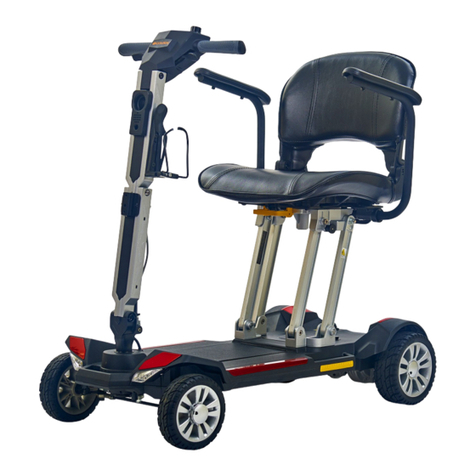
Golden
Golden Buzzaround Carry On User manual

Golden
Golden LiteRider GL111 User manual
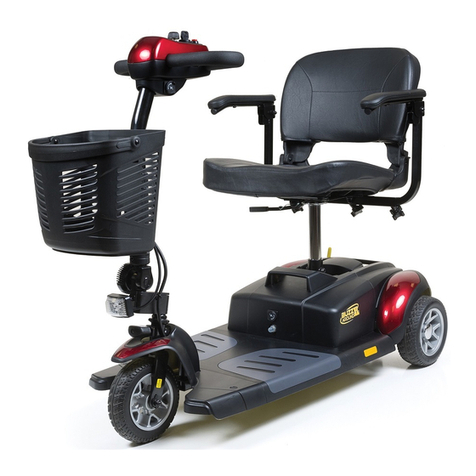
Golden
Golden Buzzaround XL GB117 User manual

Golden
Golden Buzzaround Lite User manual
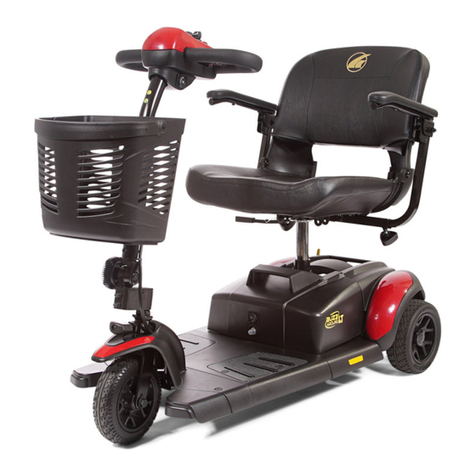
Golden
Golden Buzzaround XL Series User manual

Golden
Golden Buzzaround Extreme GB118EX User manual

Golden
Golden Companion II User manual

Golden
Golden GB-106XR Buzzaround Lite User manual
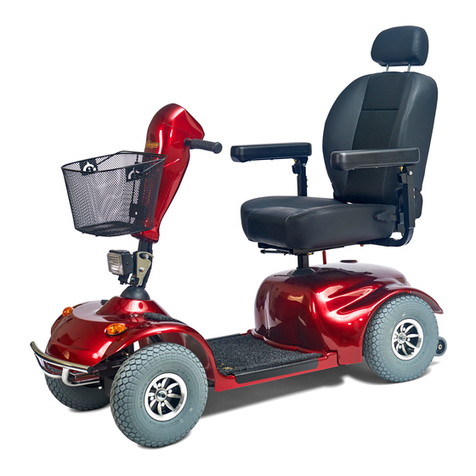
Golden
Golden Avenger GA541 User manual
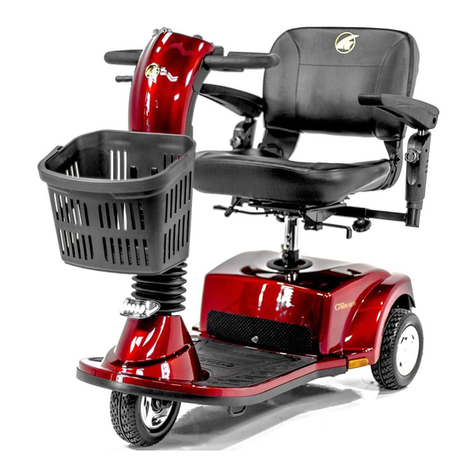
Golden
Golden GC240 User manual
